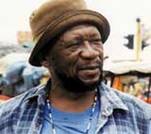The Cape Town skyline is being ripped apart by a series of violent explosions, flashing flame and light against the backdrop of Table Mountain -- or at least it will be, as soon as the animators on "Charlie Jade" drop in computer-generated imagery.
"Jade," a 170 million rand ($27.4 million) sci-fi noir TV series filming in South Africa's legislative capital, is not the only thing booming in the city: Cape Town's features industry is 140% ahead of last year's revenue pace, according to the Cape Town Film Office, and insiders predict that the action will become more ballistic following the recent launch of a government rebate scheme.
Announced last month by South Africa's Department of Trade and Industry, the scheme has set aside 252 million rand ($40.7 million) to be distributed during the next three years. To qualify for as much as 10 million rand ($1.6 million) of that money, a company must spend at least 25 million rand ($4 million) on a project and shoot at least 50% of its principal photography in South Africa.
"The incentive is probably the best thing that could have happened to this country," says Chris Roland, executive producer on "Jade" and co-owner of local production house the Imaginarium, whose recent film credits include United Artists' upcoming war-drama release "Hotel Rwanda." "It shows that the government recognizes film as a rapidly growing and very viable industry in terms of job creation and hard-currency returns. I predict a massive influx into South Africa."
Servicing international commercials has long been a mainstay of the local production industry, built on a combination of affordability and quality thanks to adept crews and a weak currency. But with the rand strengthening to about 6.2 to the dollar (from a record-low 13:1 exchange rate in 2002) and Cape Town's tourism-related prices skyrocketing, the commercials trade has taken a 30% knock compared with last year's pace, according to the Commercial Producers Assn.
On the other hand, feature production is thriving, both in servicing international productions like the upcoming Nicolas Cage vehicle "Lord of War" and in creating original content like "Jade," a South African/Canadian co-production. Teri-Lin Robertson, head of Reeleyes Film -- a company now in preproduction on "Lord" -- believes that South Africa is opening up as a movie destination.
"It seems to be a boom time for the industry," she says, adding that "Lord's" producers were drawn to the wealth of South Africa's locations and the diversity of its population, both of which have made it possible to shoot scenes (with matching extras) that take place in 39 locations from Afghanistan to Sierra Leone.
Philip Key, co-owner of Moonlighting, one of South Africa's largest production houses, attributes the steady rise of the local features industry to the strategic planning that goes into longform production, which is not as subject to the whims of currency exchange rates as is something like the commercials industry.
"We have had enormous growth over the last decade, but now we're emerging out of the period built on a weak currency with a country equipped to the hilt with crew and equipment and a world-leading business ethic," Key says. "If anything, the strengthening rand is going to normalize the situation because now we have to compete on value, rather than just a cheap currency. I think we'll end up in a far better position than before."
Moonlighting has serviced more than 60 international commercials and five features during the past year, including Paramount's planned 2005 release "Ask the Dust," starring Colin Farrell and Salma Hayek. Production activity on those films collectively brought in more than 375 million rand ($60.4 million), "which, in terms of production value, way eclipses commercials," Key says.
That income is significant for the economy of South Africa, where domestic and international movie production combine to generate about 6 billion rand ($967 million) in annual revenue -- about 40% of which is spent on local labor, according to Cape Film Commission chief operations officer Martin Cuff.
"It's especially relevant if you consider that South Africa has a 40% unemployment rate," he says. "It's not hard to see why the government has decided that the film industry is a strategic growth sector that needs stimulating."
David Wicht, managing director at major local player Film Afrika, has two films in preproduction expressly because of the DTI rebates. But he is quick to note that that incentive is not the only reason productions are coming to South Africa, "which is important because we have to create an industry that is sustainable," he says. "These incentives will not be around forever."
For the time being, though, the incentives are making a difference. Qualifying foreign productions stand to receive back as much as 15% of their budgets, but the rebate jumps to 25% for local projects and co-productions -- a measure that South African industry heavyweight Anant Singh believes will shift the sector's focus from being a service center to a major manufacturer of original content.
Singh is one of the nation's leading producers with more than 55 local and international features under his belt, including the top-grossing 2001 local comedy "Mr Bones." He also heads the 400 million rand ($64.5 million) Dreamworld Film City studio complex, being built in Cape Town with the assistance of a 60 million rand ($9.7 million) injection from the Western Cape provincial government.
"The incentive will go hand in hand with the studio in attracting international and local business," Singh says, noting that Dreamworld is scheduled to open in 2006. "Having these kinds of financial tools is going to be instrumental in establishing our future talent."
Dimitri Martinis, senior policy manager at the National Film and Video Foundation, believes that the next critical step in growing the South African movie industry is attracting private investors.
"Government is not in the business of business; we know that allowing private investors to get involved will have a far greater positive effect in developing a sustainable industry that operates according to market principles," he says. "The rebate makes that possible."
Raising money for locally produced independent films traditionally has been an uphill struggle in South Africa. Just ask Bonnie Rodini, writer and executive producer of the $3 million feature adaptation "The Story of an African Farm," which debuted in May at the Marche du Film in Cannes.
"Private-sector investment didn't exist at the time I was raising money for the film," she says. "It was seen as far too high-risk, and one potential investor I cold-called actually cut me off by saying, 'I don't do charities.'"
Rodini sees the DTI rebates, coupled with the newly respectable Section 24F of the SA Income Tax Act -- which fell into disrepute amid widespread scams and abuse during the apartheid era -- as fundamental to changing such attitudes.
"The difference between then and now is remarkable, there's no question about it," she says. "For future projects, I'm not going to have to beg people to get involved; now, it's part of the business deal."
Of course, the local industry still faces challenges -- not least of which is securing international distribution deals, often a critical requirement in obtaining financing, particularly from the South African government's Industrial Development Corp.
"Unlike Australia, we don't have sufficient local audiences to sustain an indigenous industry; we have to look to the international market to recoup our costs and make a profit," Wicht says. "The long-term solution is to develop audiences, and I think as the economy grows, we will see audiences grow. But right now, for the vast majority of South Africans, cinema tickets are an unaffordable luxury; we need to emulate the Indian Bollywood and Nigerian Nollywood models, which are low-cost but high-volume."
The other big issue is convincing foreign movie productions to finish in South Africa.
"Until now, Cape Town has been a front-end industry: International productions come here, shoot and leave," says Barry Strick, postproduction manager at Sasani Film, which is doing transfers, digitizing and director's cuts on "Jade." "In the case of 'Charlie Jade,' it's because of the regulations of the co-production treaty -- they shot in South Africa, so they have to do the final post in Canada -- but it's more common that the director and producer simply don't want to stick around for another six to eight weeks when they could do the post at home."
But Strick is optimistic about the effects of the DTI rebates.
"There has been a positive upswing in the local post industry over the last year, and since the rebates were introduced, we've already seen a growth in the number of budget requests for full post -- including ones from India, which has never been a market for us before," he says. "It's early, but I think the incentives have the potential to change the local postproduction landscape."
Like nearly everyone else in the local industry, "Jade" executive producer and showrunner Robert Wertheimer is keen to see precisely how the DTI rebates will affect filmmaking in South Africa.
"It's very interesting for us as Canadians when our local entertainment industry in Canada exists precisely because of the existence of tax-credit investment," he says. "In Canada, those tax credits have been beneficial to suppliers, unions, technicians and actors but evolved as less of a support system for Canadian culture and talent like producers, lead performers, writers and directors; hopefully the incentives in South Africa have been designed to avoid those mistakes and to nurture and protect the indigenous culture."
Source: Hollywood Reporter









